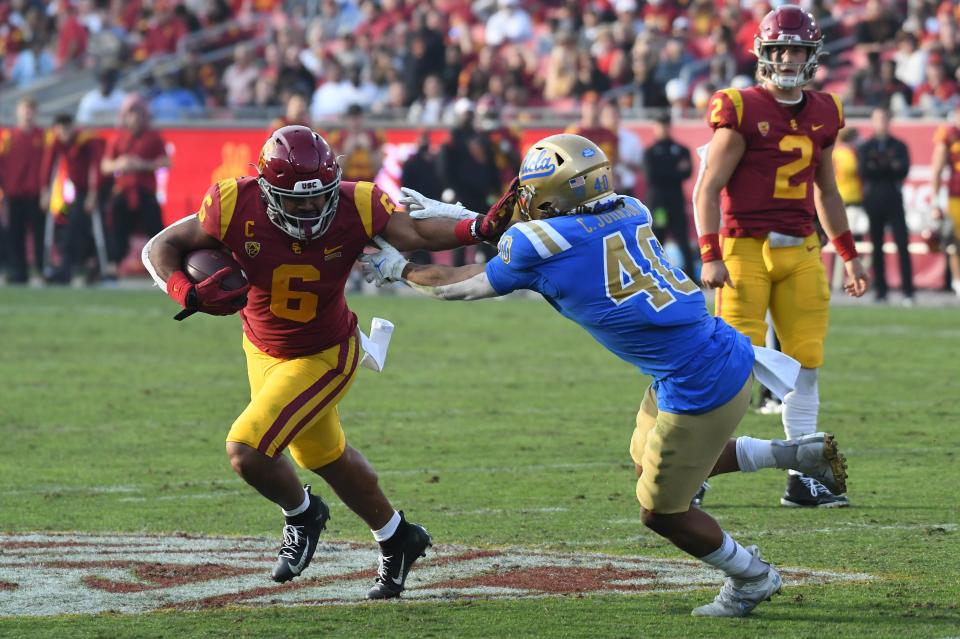With UCLA and USC joining the Big Ten, college football's future is two super-conferences
With Southern California and UCLA leaving the Pac-12 to join the Big Ten in 2024, college football is taking an irreversible step toward the construction of two major conferences at the expense of tradition and the remaining Power Five leagues.
While viewed in administrative circles as a possibility since the first round of significant conference realignment a decade ago, the birth of these super leagues creates a chasm of space between the rest of the current Football Bowl Subdivision and the SEC and Big Ten.
USC and UCLA leaving the Pac-12 is the clearest signal yet that the top level of college football will center on dozens of teams married not by geography, rivalry or history but the chase for increasingly large media-rights payouts and broadcast deals.
Instead of merely a possibility, these super-conferences are now here.
Now that this latest conference realignment is official, the fallout will be swift and seismic.
OPINION: Apocalypse, now! College sports has become another corporate proxy war
MORE: Look inside UCLA, USC trophy cases
ARCH MANNING: Peyton weighs in on nephew's commitment
NEWSLETTER: The biggest sports news straight to your inbox
While the Big 12 was able to partially offset losing Texas and Oklahoma to the SEC by gobbling up the best teams from the American, the Pac-12 will have no options among the Group of Five ranks even remotely close to matching the reputation, success and television appeal of the two Los Angeles-based schools.
The Pac-12 could next lose Oregon and Washington, the next two members with the draw and support to be an option for further West Coast expansion.
In that scenario, the Pac-12 would need to dip deep in the Group of Five — for Boise State and San Diego State, to start — just to create a lineup of schools with enough relevance to simply maintain existence in the Football Bowl Subdivision.

Even in the hypothetical where the Pac-12 and Big 12 merge, that league would still be miles behind the SEC and Big Ten in terms of overall competitiveness in the race for the national championship.
That leaves the Pac-12 with only one hope: That the Big Ten accepts the entire conference, warts and all, perhaps motivated by the longstanding relationship with the conference built through the Rose Bowl.
But doing so would dilute the Big Ten’s overall strength and do nothing to move the needle during the league’s current TV rights negotiations.
Instead of going deeper into the Pac-12, both the Big Ten and SEC could take aim at the best available programs elsewhere: Clemson, Florida State, Miami and the top tier of the ACC, along with Notre Dame.
While the Irish aren’t subject to the same concerns, the flagbearers in the ACC would be motivated to change conferences for the same reason USC and UCLA jumped ship: ACC schools will make millions less per year than the SEC and Big Ten schools, with the total set to grow dramatically when the Big Ten signs its new TV deal.
USC and UCLA are the tipping point for a new world order. Eventually, every school with designs on competing for the national championship will push and shove in an attempt to get to the front of the line and beat the crowd into one of the two super-conferences.
That may result in the second major shakeup in the divisional structure of college football in the past 50 years, following the creation of Division I and Division I-AA (later renamed the FBS and Football Championship Subdivision) in 1978. This time, the split will place the two super leagues in one tier and the rest of the current FBS in another.
The unofficial gap between the haves and have nots will have a clear line of demarcation. The future of college football is clear: two super-conferences will be centerstage.
Follow colleges reporter Paul Myerberg on Twitter @PaulMyerberg
This article originally appeared on USA TODAY: UCLA, USC to Big Ten: College football's future is 2 super-conferences
